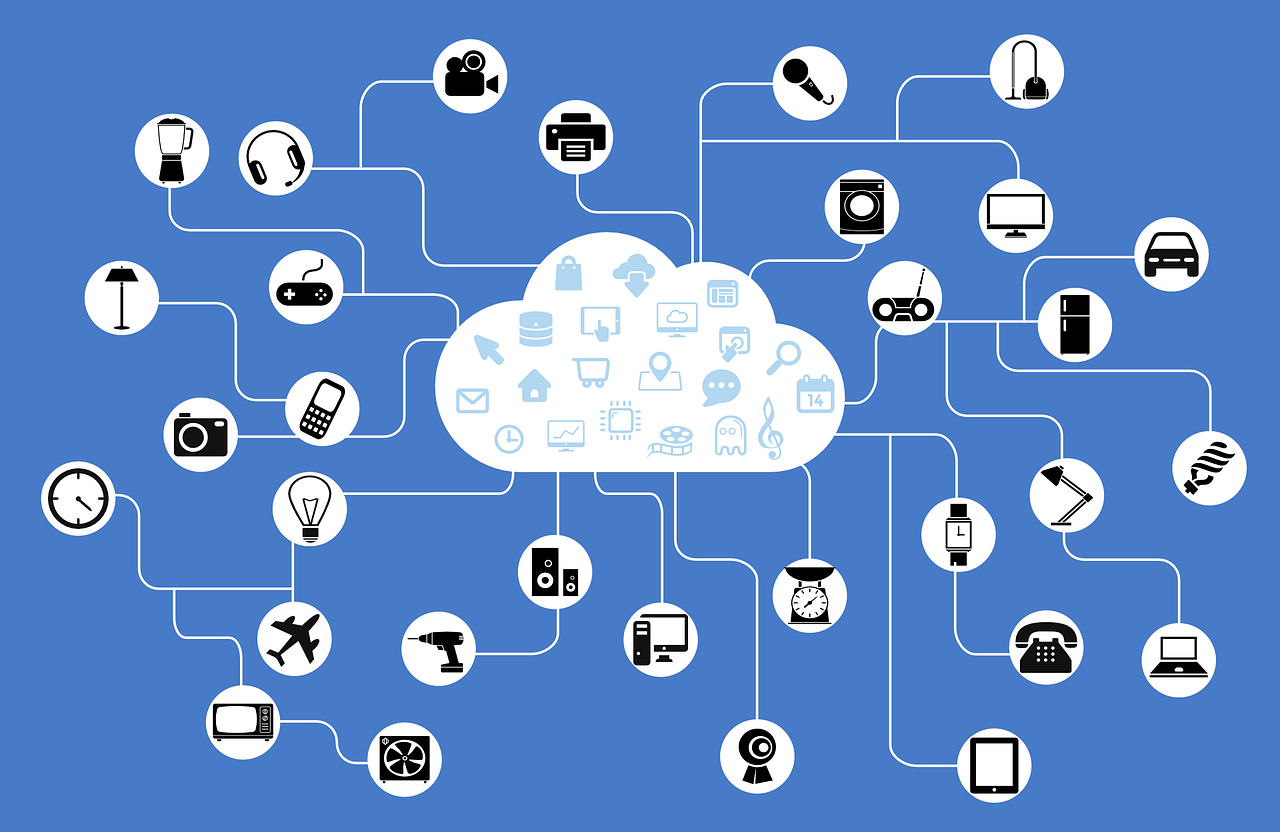With its rapidly accelerating expansion and far-reaching effects, the Internet of Things (IoT) is demanding that technology have a broader inclusion within corporate strategy than ever before. But it’s not about the technology…it’s about your business.
IoT’s exploding growth has been well-documented. In 2000, there were only 361M internet users worldwide.1 That had grown to 10B internet-connected devices in 2015 with projections to grow to 34B devices by 2020. It is interesting to note that traditional computing devices (including smartphones, tablets, smartwatches, etc) will comprise less than a third of that number.2 As processing power, storage, and bandwidth continue to increase at ever-lower prices, shrinking form factors bring possibilities never before imaginable. Today, for example, a computer the size of a grain of salt (1x1x1 mm) includes a solar cell, thin-film battery, memory, pressure sensor, and wireless radio and antenna.3 The resulting smart, connected devices are revolutionizing products, disrupting value chains, reshaping industries, creating new competitive threats, and causing companies to rethink and retool nearly everything they do internally.4
Let’s take a look at a couple of strategic questions your company must address because of IoT:
What role will your company play?
The IoT offers tremendous possibilities and opportunities. In general terms, companies can choose to:5
- Embed – Use sensors and monitors to enhance your knowledge of and relationship with your customers while also improving your own products and operations. United Parcel Service trucks have been equipped with sensors for years achieving significant cost savings from operations improvements.
- Enable – Supply the underlying technology including endpoints, hubs, network and cloud services, and enhanced platforms. For instance, Thinkworx offers companies an IoT software development platform along with real-time and predictive analytics capabilities.
- Engage – Provide the direct link between the IoT and the customer. Perhaps you will seek to furnish the digital glue like Nest, the smart thermostat maker now owned by Google. This digital glue supplies the entire platform needed to interface with Nest products or with any other product connected with Nest – standards, software, infrastructure, security,etc. While there are distinct advantages to building this digital glue, it is certainly not without significant costs and risks. You may instead choose to build products that connect with someone else’s platform. Ford, for example, has announced that it will connect with Amazon Echo to allow car owners to start their car using a voice command from the kitchen or turn off their living-room lights from their car.6
- Enhance – Bring enhanced value from IoT data and relationships. Customers of John Hancock’s Vitality program, for example, can earn life insurance premium discounts based upon IoT evidence of an active lifestyle collected from their Fitbit.7 Or take Beam who is using data collected from a connected toothbrush to offer lower group dental rates to employers whose employees practice better dental hygiene.
Should you move toward a new business model?
Historically most companies have operated under a closed approach in that total control was maintained. Product/service enhancements were done on their timetable, and customers either accepted that or bought from someone else. There was little thought of how this fit into the bigger picture. A more open approach recognizes that you are a part of a larger ecosystem and promotes connectivity with outside components.
Today 40% of executives believe that moving to a platform-based business model and engaging in ecosystems of digital partners are very critical to their business success.8 A platform must bring a useful function or service and should provide third party access in addition to governance. The network effect facilitated by these partners brings a much stronger solution. Combining partnership resources causes product/service innovation, development, and deployment to occur at a much more rapid rate by bringing many more resources to bear than a single company can afford. At the same time these partners are developing solutions that work with your product (and vice-versa), they are attracting more customers to the overall solution. As a result, platforms beat products every time.9
The IoT can also allow you to consider moving from a product-centric offering to services and solutions. For example, Rolls Royce manufactures jet engines and has traditionally competed on price with other manufacturers. But now sensors capture mountains of data and transmit it in real-time to the company while the plane is in flight. This has allowed Rolls Royce to move to a monthly subscription model where the customer pays for usage. This new service model incents Rolls Royce for predictive maintenance to keep the engines running, and their customers also benefit from decreased downtime – a win-win scenario.10
By moving to a product-as-a-service model, a company can protect its aftermarket sales and service business, which is often quite profitable. However, making such a move from the traditional sales and service model quickly can have a significant negative effect on the bottom line. One option is to employ some sort of product-service hybrid model to continue to generate the traditional sales but provide some level of protection to your aftermarket business.11
Conclusion
You must not get caught up in thinking that the IoT is about things or even about data. It is about how you can use definitive information to make a difference in your business. That means it must go beyond simply placing sensors on products and collecting data. The value is in analyzing what you collect and using that analysis to make decisions.
The IoT has a potential effect of $14.4 Trillion on corporate bottom lines (increased revenues and decreased costs) by 2022.12 This effect will come not only from new value created by IoT but also from a redistribution of value between winners and laggards, depending upon how well companies take advantage of IoT opportunities.
This is not something that can wait until your next annual planning meeting. The journey is not short, yet the pace is swift. It favors the bold and could irreparably harm those who hesitate too long. Determine your direction, get people on board with your strategy, and charge ahead. The time to start is NOW!
Sources:
1 “The Incredible Growth of the Internet since 2000 – Pingdom Royal.” Pingdom .com. Tech Blog, 22 Oct. 2010. Web. 28 June 2016. http://royal.pingdom.com/2010/10/22/incredible-growth-of-the-internet-since-2000/
2 Greenough, John. “How the ‘Internet of Things’ Will Impact Consumers, Businesses, and Governments in 2016 and beyond.” Business Insider. Business Insider, Inc, 18 Apr. 2016. Web. 28 June 2016. http://www.businessinsider.com/how-the-internet-of-things-market-will-grow-2014-10
3 Handler, Doug, Joel Barbier, and Joseph Bradley. “Embracing the Internet of Everything To Capture Your Share of $14.4 Trillion.” IoE Economy/WhitePaper (n.d.): n. pag. Cisco.com. Cisco. Web. http://www.cisco.com/c/dam/en_us/about/ac79/docs/innov/IoE_Economy.pdf
4 Heppelmann, James E., and Michael E. Porter. “How Smart, Connected Products Are Transforming Competition.” HBR.com. Harvard Business Review, 01 Nov. 2014. Web. 28 June 2016. https://hbr.org/2014/11/how-smart-connected-products-are-transforming-competition
5 Burkitt, Frank. “A Strategist’s Guide to the Internet of Things.” Strategy+business.com. PwC Network, 10 Nov. 2014. Web. 28 June 2016. http://www.strategy-business.com/article/00294
6 Bishop, Todd. “Ford Meets Amazon: Automaker to Integrate Echo and Alexa with SYNC, Linking Cars to Homes.” GeekWire. N.p., 04 Jan. 2016. Web. 28 June 2016. http://www.geekwire.com/2016/ford-working-on-amazon-echo-integration-connecting-cars-to-homes/
7 Bernard, Tara Siegel. “Giving Out Private Data for Discount in Insurance.”The New York Times. The New York Times, 07 Apr. 2015. Web. 28 June 2016. http://www.nytimes.com/2015/04/08/your-money/giving-out-private-data-for-discount-in-insurance.html
8 3, Trend. Platform Economy: Technology-driven Business Model Innovation from the outside In2 (2016): n. pag. Accenture.com. Web. 28 June 2016. https://www.accenture.com/t20160125T111719__w__/us-en/_acnmedia/Accenture/Omobono/TechnologyVision/pdf/Platform-Economy-Technology-Vision-2016.pdf
9 Parker, Geoffrey, and Marshall Van Alstyne. “Platform Strategy & Open Business Models.” Eisenmann, Parker & Van Alstyne (2011): n. pag.Http://ebusiness.mit.edu/. Boston University School of Management. Web. http://ebusiness.mit.edu/platform/agenda/slides/5%20Platforms%20Transitions.pdf
10 Shakib, Tony. “The Digital Manufacturer: Differentiating with New Service-Oriented Revenue Models.” Cisco Blog RSS. Cisco, 12 Jan. 2016. Web. 28 June 2016. http://blogs.cisco.com/digital/the-digital-manufacturer-differentiating-with-new-service-oriented-revenue-models
11 KELLINGLEY, Nick. “Product-Service Hybrids – When Products and Services Become One.” Interaction Design Foundation UX. N.p., June 2016. Web. 28 June 2016. https://www.interaction-design.org/literature/article/product-service-hybrids-when-products-and-services-become-one
12 Handler, Doug, Joel Barbier, and Joseph Bradley. “Embracing the Internet of Everything To Capture Your Share of $14.4 Trillion.” IoE Economy/WhitePaper (n.d.): n. pag. Cisco.com. Cisco. Web Ibid, http://www.cisco.com/c/dam/en_us/about/ac79/docs/innov/IoE_Economy.pdf
About The Author:
Tag/s:Internet of ThingsIoT





